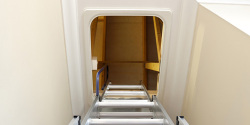

A recent study has revealed loft insulation in most homes is typically providing only 50% of the energy savings homeowners have been led to believe they would.
The research, completed by the National Physical Laboratory (NPL), shows that squashing loft insulation halves its performance levels.
Further research, sponsored by the Carbon Trust, showed that 82% of households use their loft for storage, compressing insulation either by boarding the loft, or putting belongings on top of the insulation.
According to the Energy Saving Trust, a quarter of a home's heat goes out through an un-insulated roof, and therefore squashing loft insulation has a significant impact on peoples' energy bills.
The government recommends a 270mm-thickness of of insulation in the loft, far greater than the typical 100mm height of building joists, meaning that insulation is often compressed if a loft is boarded or used for storage.
The Carbon Trust research was published in 2012. It found that 82% of households use their loft for storage, and 78% say the loft is greater than half full. Some 65% have fully or partially boarded their loft (which means the insulation cannot be more than 100mm deep, while only 26% said they knew that compressing insulation made it less effective.
"This is not a recent problem, it has been around since lofts started to be insulated," said Dave Raval, chief executive of LoftZone, a company that manufactures loft insulation solutions. "We all know that people use their lofts for storage. But compressing insulation halves its performance and what's worrying is that so few households realise this. If you live in a house, and are worried by your fuel bills, don't use your loft for storage unless you have protected the insulation first."
If you'd like to keep up-to-date with the latest developments in the heating and plumbing industry, why not subscribe to our weekly newsletters? Just click the button below and you can ensure all the latest industry news and new product information lands in your inbox every week.